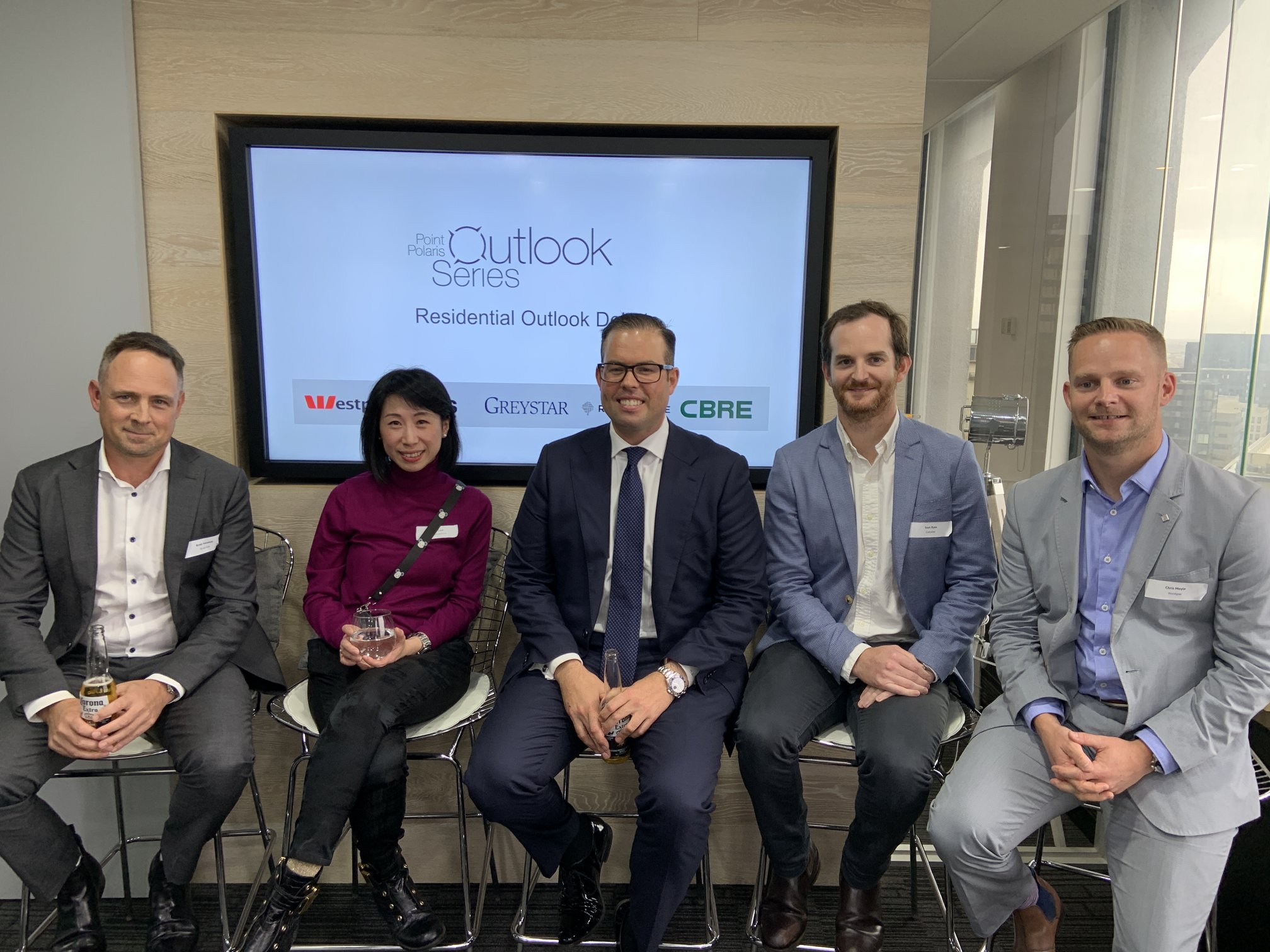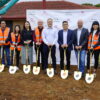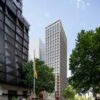Point Polaris is seeing significant optimism return to the residential market. We are working on projects of all scales and typologies from boutique owner occupier apartment and townhouse projects to large residential towers geared more towards investors. We have helped Greystar in their recent acquisition in South Yarra, which will be Australia’s biggest Build to Rent project and we have recently kicked off a new land sub-division project.
But what is next for the Residential market?
- Does innovation = greater risk?
- Is 2020 the year of the Investor, Owner/Occupier, Renter?
- Development sites – where is hot, where is not? Are they still overpriced?
- The importance of finding the right builder – is it getting harder?
- Is funding going to loosen up
- Is sales success all about Price, location, design – do people expect / want more?
Point Polaris assembled a stellar panel including Chris Moyle (CM), Director & Head of Real Estate (VIC) at Westpac; Jessica Liew (JL), Director at Plus Architecture; Sean Ryan (SR), Director of Development at Greystar; Brett Howlett (BH), Project Director at Riverlee; and Henry Burbury (HB), Director at CBRE to discuss these issues and more, moderated by Managing Director, Andrew Hogan (AH)
General Views:
CM: Pre-sales are still generally moving slowly and so it is a challenging environment to lend into. Banks want to participate and support good customers and product, but there are constraints as to the volumes we can do on traditional development loans with relatively low presales.
Whilst there are challenges, we are still funding large and small residential developments, backing good customers and using innovative structures to participate while meeting our risk and regulatory obligations. We are generally optimistic about residential as we see supply dropping off in the coming 18-24 months.
HB: 2019 was a challenge but since the Federal Election optimism has returned. In 2020 we have already seen a strong return of the downsizer and owner/occupier market.
I had 115 Groups through recently at the new Walker Corporation development in Kew. After that first weekend, we are already at 85% sold.
Developments of 50 units and less in blue chip suburbs close to retail amenity are definitely the ones that have bounced back quickest and strongest
But towards the back end of the year we anticipate seeing the return of investors interested in medium/high density product.
BH: We definitely feel confident being in the Owner-occupier space right now. Our Seafarers development on Northbank, includes 125 high-end apartments with a median price point of $2.2m. We already have 30% away without a proper launch
Most of these sales are coming through the display suite. People will come through 3 to 4 times before they buy, so it is about developing a relationship with them and establishing a culture of trust that addresses and solves their needs. Price is less of an issues.
SR: With more than 500,000 units under management and 25 years’ experience in Build-to-Rent (or multi-family as it is known in the States), Greystar has a real understanding of how people live
Putting the tax barrier challenge to one-side, both we and the BTR movement more generally is gathering momentum and the supply/demand metrics are starting to stack up.
The model is tight though with leasing velocity balanced by construction prices.
CM: Conceptually the Banks understand the BTR value proposition and are supportive. We do occupy the less-risky end of the spectrum so there are challenges around “banking” new income streams and also the bases for valuations that will make high gearing challenging initially. In this sense there are similarities with student accommodation in the early 2010’s.
SR: That Greystar is backed by top tier funds is starting to give the banks more certainty and confidence.
JL: From a design perspective, for the owner-occupier market customisation is key. As architects our designs need to have the ability to flex and adapt to specific needs.
With investor stock product, we are finding that the 1-bedroom is making a big comeback
We have been involved in a recent project where 80% of the development is 1-bedders rather than the 80% 2-bed mix that had started becoming the norm.
The Rise of the 1-Bedder
JL: It should be noted that the rise of the 1-bedder in our experience is demographic specific and not a universal trend.
BH: The industry definitely needs to give more thought to the 1-bed product again. If Riverlee had our time again we would put more 1-bedders in Seafarers. We have some 60+sqm 1-bedders priced at $825k. This is new territory from a price point. It is clear that money is not the driver, it is about having a city centre bolt-hole.
And from a developer’s perspective it also gives flexibility. It is fairly easy to combine them to make larger apartments if necessary.
HB: Absolutely agree. At The International in Brighton for Landream and V-Leader. We had 6 1-bedders forced on us. They are around 75sqm in size and priced at $785k but two have already sold. They are seen as affordable relative to the wider Brighton market and ideally suited to a divorcee/widower keen to stay in the suburb.
Coronavirus Impact
HB: From a sales perspective we are not panicking. We still have strong clearance rates, lower interest rates and are viewing it as a speed hump. Good suburbs will always bounce back quickly
BH: It is certainly permeating through the property market, but we are a sentiment- based industry; whether it was APRA, C270 or SARS, history has told us that the market deals with it
SR: The biggest challenge is the reliance on China for our building supply chain. Greystar may not have anything under construction but delays on site are going to occur and the knock on effect is surely to last a good way through 2020.
AH: Our contracts protect our clients and so we are having to work collaboratively with builders to find solutions, because unfortunately for them it is “your delay, not ours.”
CM: The problem is we really don’t know how big an issue it is or will be. Banks are in the risk game and at the moment the risk is more uncertain and unstable. It is not an economic event like we’ve become somewhat accustomed to so may have an unpredictable impact. It’s therefore a good time to remain alert, think system-wide and not under-estimate the possible impact. But the uncertainty will bring opportunity, and never waste a crisis!
Flammable Cladding: Is It Still A Question?
BH: The off the plan market is very sophisticated now. More often than not the first question we get is ‘who is building the development?’
There is natural scepticism in the off-the-plan market; It is not just cladding but the structure and the interior finish.
We believe that a good marketing campaign relies on a good builder being part of that. We like the Early Contractor Involvement (ECI) process as it creates a partner mentality that works throughout the life of the project.
HB: A at recent downsizer event we held in Brighton, the flammable cladding question was a ‘go to question’ in most conversations we had. CBRE also supports early appointment of a builder.
But does also depend on the product; it is an issue for the owner-occupier but less so for the investor
Amenity: Creating Communities
HB: For the downsizer, a common question we are asked is: ‘What is my body corporate fee?’
They want the apartment to look amazing and have a community feel but they are less concerned about the gym or the sauna. They prefer low cost amenity like a grand arrival or rooftop space. But for the investor market they need the bells and whistles.
JL: Plus Architecture handed over a project at the end of last year with no amenity. It is located in the heart of Glen Waverley with everything on the doorstep and the client sold the suburb amenity.
So as not to impact on body corporate fees we are now designing more penthouses with their own private pools and gyms.
SR: In BTR we are trying to build a community and actively encourage residents to leave their apartments. We put our amenity in the best parts of the building so everyone can enjoy the views of the city, for example
Volume in the building is needed though to make it work cost-effectively.
Beyond the physical amenity, we are also looking more and more at social amenity. In the States ‘dog runs’ resonate, for example, where we encourage, not exclude dog owners. In San Diego, their development even has a ‘dog of the week’ award!
Fostering and encouraging the Interaction of residents and curating events managed by Greystar staff gives an extra layer to our developments.
Planning: Does It Help To Have A ‘Sexy Building’
Phil Gleeson, Urbis (Audience Member): Good design and good amenity definitely help in selling a proposal to the council and community.
Blue chip suburbs also demand a blue chip architect. Buyers demand a brand; “not only do I live in suburb X but I live in a building designed by architect Y.”
Is Climate Change still a driver?
BH: All developers should be socially responsible. Having a green story still helps from a marketing perspective. The question is whether the market is prepared to pay for it. Our experience is they would rather pay for the amenity.
Small gestures, like green switches, that are tangible and not cost-prohibitive are better.
JL: We are again finding with this that it is demographic and buyer dependent too. It is more likely to make a difference in Brunswick than South Yarra.
SR: As long-term owners we take a full lifecycle approach to our developments. We like systems that provide operational efficiency and reduce maintenance and running costs for our tenants.
Affordable Housing: Should It Be Mandated by Government
AH: When helping clients acquire sites, we advise on and create strategies for the highest and best use of these sites. Unfortunately, at the moment, affordable housing is never going to give you the best returns. There can only be a level playing field if it is mandated








